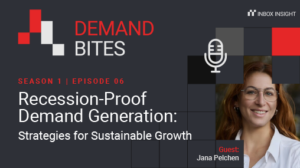In the realm of Account-Based Marketing (ABM), two terms frequently arise that B2B marketers often struggle to comprehend – demand generation and lead generation. While these two concepts may seem interchangeable, they in fact serve unique roles in any B2B marketing strategy. Yet, understanding the difference between demand gen and lead gen is crucial to the success of your marketing efforts.
This article delves into the world of demand generation vs lead generation, dissecting their meanings, roles, strategies, and the key differences between them. It will provide you with a clear understanding of these two concepts and how to effectively integrate them into your marketing strategy.
Reading time: 5 minutes
Decoding demand generation
If you’re wondering what is demand generation, often abbreviated as demand gen, it is a multifaceted marketing strategy aimed at sparking interest in your business’s offerings. It’s about making your brand known, educating your audience, and building trust with them.
The ultimate goal of the demand generation process is to cultivate a buzz around your brand that propels your target audience through the sales process. It’s a long-term strategy that focuses on building brand awareness and positioning. Think of demand gen as the foundation upon which your marketing and sales efforts are built.
Key components of a demand generation strategy
A successful demand generation strategy contains several key components, and it’s important to leverage the right demand generation tools for effective marketing campaigns.
Here are five essential elements your marketing team needs to consider:
- Utilize amplification and analysis tools: A robust technology stack can exponentially enhance your demand generation efforts, broadening your reach and improving campaign performance.
- Set clear goals: Your demand gen goals should primarily revolve around boosting brand visibility and increasing market penetration.
- Cultivate brand awareness: In a fiercely competitive marketing landscape, sustaining brand awareness is key to ensuring a steady influx of potential leads.
- Experiment with alternative marketing strategies: Attention-grabbing strategies like influencer marketing, experiential marketing, and guerilla marketing can help amplify brand awareness.
- Produce informative and useful free content: This includes blogs, webinars, podcasts, videos, eBooks, and more. High-quality, relevant content helps establish your brand voice and authority in your industry.
Unlocking lead generation
Lead generation, often referred to as lead gen, takes demand gen a step further. It is the process of nurturing the interest you’ve generated and converting it into potential customers. It’s about taking that buzz you’ve created around your brand and turning it into tangible leads that can potentially result in sales.
Unlike demand gen, lead gen is more transactional. It’s directly concerned with collecting information about potential buyers and nurturing them through the buying journey until they’re ready to make a purchase.
Key components of a lead generation strategy
A lead gen strategy requires several key components to be successful. Here are seven essential elements you need to consider:
- Establish a lead capture system: Without a strategic lead capture plan, it can be difficult to guide prospects into your sales funnel.
- Develop lead magnets: A lead magnet is an offer made in exchange for a prospect’s contact information. These can include product trials, whitepapers, exclusive discounts, and more. For effective lead generation, consider developing enticing lead magnet ideas that resonate with your target audience.
- Optimize landing pages: Landing pages play a vital role in the success of your lead magnets. They serve as a destination for your ads and a tool to keep leads focused. So it’s crucial to adhere to lead generation landing page best practices when designing and optimizing them.
- Leverage social media: Social media is a crucial part of lead gen, offering both paid and organic channels to promote your offerings and engage with your audience. Social media posts and ads should be regular and engaging.
- Use marketing automation workflows: These workflows help you create systems and processes to expand your reach and monitor the effectiveness of your lead generation marketing campaigns.
- Develop a lead scoring system: This system helps you prioritize your inbound leads based on their engagement level. Your aim is to see more high-quality leads that match your ideal customer profile (ICP) and target account lists (TALs).
- Invest in remarketing: Remarketing allows you to stay connected with site visitors and strike a chord with your brand across different parts of the internet.
Demand generation vs lead generation: The main difference
The primary difference between demand generation and lead generation lies in their respective objectives and stages in the sales funnel. Demand generation is at the top of the funnel, where your goal is to generate awareness and interest in your brand. On the other hand, lead generation is at the bottom of the funnel, where the focus shifts to nurturing those interested prospects and converting them into customers.
Strategizing the marriage of demand gen and lead gen
The true power of demand gen and lead gen is unleashed when they work together in harmony. Instead of choosing between the two, businesses should aim to integrate both into their marketing strategy, supported by appropriate tools and software.
Having a strong demand gen strategy in place lays the groundwork for effective lead gen. However, it’s crucial to remember that these need to be data-driven strategies. Understanding your buyer personas and using that knowledge to craft relevant campaigns is key to success. Also, employing a lead scoring system can help identify the right time to target leads with more impactful content.
Content marketing for demand generation vs lead generation
Content plays a crucial role in both demand gen and lead gen. However, the type of content used and its purpose can differ significantly between the two.
Demand generation content aims to educate your audience and build brand awareness. It typically includes free, ungated resources like blog posts, webinars, and podcasts.
On the other hand, lead gen content is more explicit about your brand and offerings. It generally includes gated content like whitepapers, eBooks, and case studies that require contact information to access.
Metrics to measure success
To evaluate the effectiveness of your demand generation and lead generation strategies, it’s crucial to monitor key performance indicators (KPIs).
When assessing demand generation metrics, consider the following:
- Website traffic
- Cost per acquisition (CPA)
- Pipeline growth
- Social engagement
For lead gen, you want to focus on:
- The quantity of quality leads
- Conversion rate
- Lead response time
- Click-through rate (CTR)
The power duo: uniting demand generation and lead generation
When correctly implemented, combining demand generation and lead generation into your marketing strategy can create a robust marketing engine that not only propels brand awareness but also drives customer acquisition.
Consider a practical scenario where a business harnesses the power of demand gen. They craft an informative and engaging eBook that ignites curiosity and fosters interest in their brand. This can be a comprehensive guide on the industry, a how-to manual related to their services, or a thought-provoking piece that addresses the burning issues in their sector. The primary goal is to stir interest and establish the brand as a thought leader, thereby creating demand in the market.
However, creating demand is only half the battle won. The next strategic move involves converting this interest into potential leads, which is where the lead gen strategy comes into play. The business could offer this insightful eBook to their audience, but with a simple condition – an email address needs to be provided in order to access the eBook.
This seemingly simple exchange serves a dual purpose. On one hand it rewards the audience with valuable information that they are interested in, while on the other hand it provides the business with a list of email addresses. These are not just any random email addresses, but those of individuals who have shown interest in the brand or its offerings, qualifying them as potential leads.
Thus, by integrating demand gen and lead gen, the company can effectively convert interested prospects into potential customers. This strategy creates a win-win situation for both the business and its audience. The audience gains access to valuable content and the business acquires a list of potential leads to nurture and convert into loyal customers.
In conclusion, the seamless integration of demand and lead gen strategies can significantly boost a business’s marketing efforts, resulting in increased brand awareness, lead generation, and ultimately, customer conversion.
Demand gen and lead gen case study example
Inbox Insight’s partnership with Kofax exemplifies the powerful combination of lead generation and demand generation strategies. Through high-quality demand generation campaigns, they’ve generated significant results. This relationship has evolved into a robust professional bond, further cemented by a sponsorship of a content hub on Insights for Professionals aimed at educating their target audience.
Inbox Insight’s data-driven approach defined precise target personas within the Software and Business Intelligence Automation industry. This strategy utilized first party intent keywords and expertly written content to engage audiences effectively. The campaign’s multichannel approach, including paid social, programmatic display, and email marketing, reached and engaged target personas, reinforcing Kofax’s authority in the Intelligent Automation space.
The ultimate success of this collaboration is reflected in the generation of $250k in pipeline, a testament to the impact of demand generation. This Kofax case study demonstrates the potential of lead generation and demand generation when executed effectively.
Final thoughts
Understanding the difference between demand gen and lead gen is just the first step. The real challenge lies in effectively implementing these strategies within your marketing efforts. Remember, it’s not about choosing between demand gen vs lead gen. Instead, the goal is to create a seamless marketing strategy that integrates both to maximize results.
Ready to supercharge your demand gen results? Explore our B2B demand generation services and lead generation services to achieve your marketing goals…






